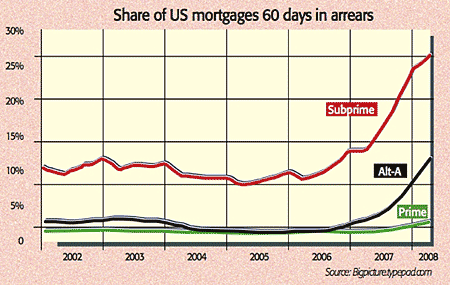
Happy anniversary. A year ago this week, “the true horror of the credit crisis hit home”, says Miles Costello in The Times, when the European Central Bank injected €95bn into the money markets in an attempt to free up lending among banks, and the US Federal Reserve soon followed suit. The storm had been brewing over the past few years, when financiers hugely increased their slicing and dicing of loans, including US subprime mortgages, into complex packages of debt, sold all over the world to investors eager for higher yields.
Trouble was first flagged by HSBC last spring as it wrote off $10.5bn because subprime debt was going bad as the American housing market had turned. By the summer, two Bear Stearns hedge funds had suffered huge losses on subprime debt and Germany’s IKB bank and two BNP Paribas funds were teetering. By last summer it had become clear that American housing was plunging and that mortgage-backed securities – especially subprime ones – were worth a lot less than those holding them imagined, as Larry Elliot says in The Guardian. With nobody sure where the losses were and how big they might be, confidence and trust were lost across the financial system. Banks stopped lending to each other and then “sought to repair their finances” by reining in lending, which has undermined growth. The credit crunch had arrived – and it will be a long time before it leaves.
Another wave of defaults on US mortgages is “building with alarming speed” as the American economy and housing market continue to deteriorate, says Vikas Bajaj in the International Herald Tribune. Of Alt-A mortgages (one step above subprime), 12% were at least 60 days in arrears by April, quadruple April 2007’s figure, while 60-day delinquencies on prime mortgages, the biggest slice of the $12trn mortgage market, doubled to 2.7% in that period. Subprime was just “the tip of the iceberg”, says Thomas Atteberry of First Pacific Advisors. Payments are rising rapidly as many of these loans are reset so that after years of just paying interest, households have to pay interest and principal every month.
Meanwhile, defaults are rising on US consumer loans and credit-card debt arrears are on the rise. And in Britain, problems “in the corporate economy are just beginning to appear”, Matthew Crest of Close Brothers told The Sunday Times. Lloyds TSB, for instance, revealed last week that bad debts had almost doubled in its commercial banking business. S&P’s prediction that US junk-bond defaults could more than quadruple next year also highlights the stress in the corporate sector. Overall, we are facing a “negative feedback loop” from the financial to the real economy and back, whereby losses for banks sap credit and growth, portending more losses for banks and a further tightening of credit as the economy weakens. So far, $400bn in mortgage-related investments have been written down, according to the IMF, and total write-offs from the credit crunch could reach $1trn. And that’s one of the lower estimates out there.
All this is hardly encouraging for equities, which globally have lost around 20% from their peak last year. Macroeconomic data in Europe, Britain and America are signalling recession, and markets look vulnerable to earnings disappointments, given that forecasts remain high and margins reached historic records in the boom years. Pan-European consensus forecasts are +2% for this year and +12% for 2009, says Morgan Stanley, whereas –14% and –17% are more realistic. Market psychology also suggests the pain isn’t over yet. “There hasn’t been this much talk about bottoms since the can-can was all the rage,” says Alan Abelson in Barron’s. Genuine market bottoms, however, only happen when people have completely given up. “Revulsion, not denial, will mark the end of this bear market.”
The big picture: reliable US recession indicator flashes red
American payrolls have slid for seven months in a row, but we have yet to see the 150,000-plus monthly declines that would definitely signal recession, as some optimists note. But dig a little deeper and there is ominous news for the bulls. The number of people unemployed for 15 weeks or more has eclipsed three million, 49% up from the December 2006 trough.
Historically, over the past ten recessions, a 49% jump from the bottom has been consistent with an economy in its seventh month of recession, points out David Rosenberg of Merrill Lynch. And there has never been a 49% jump outside a recession.